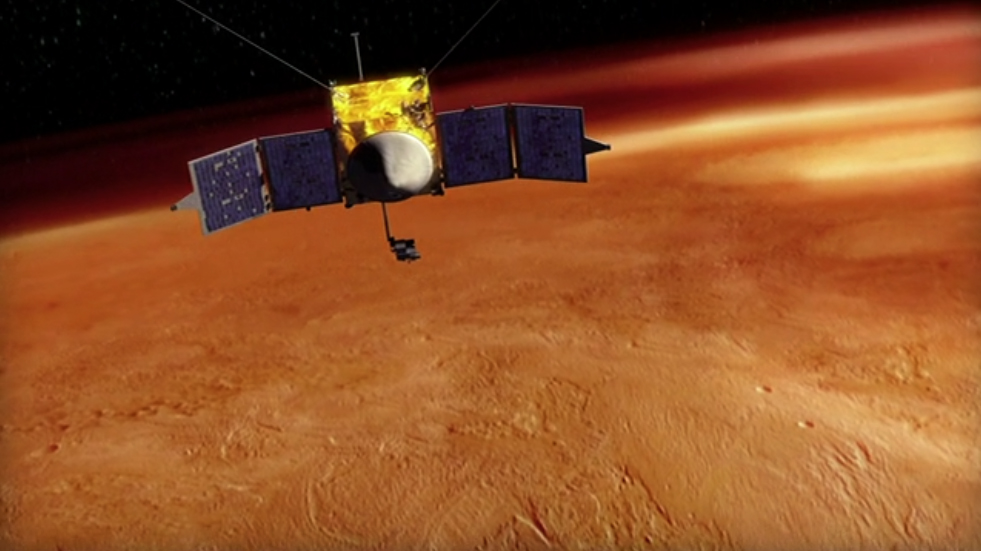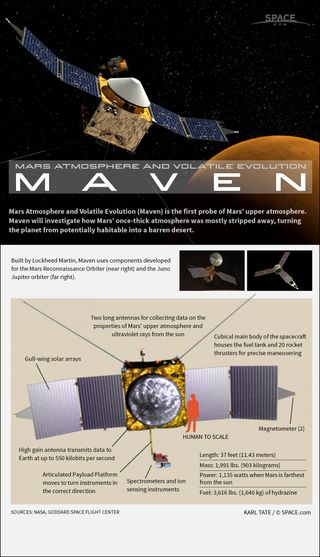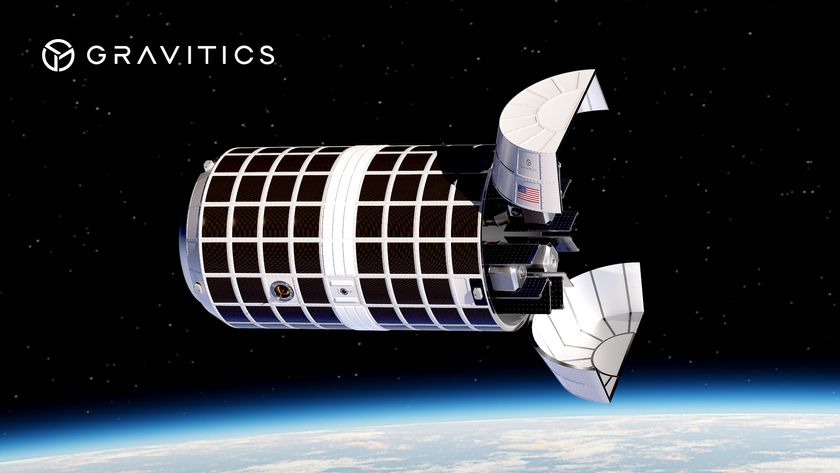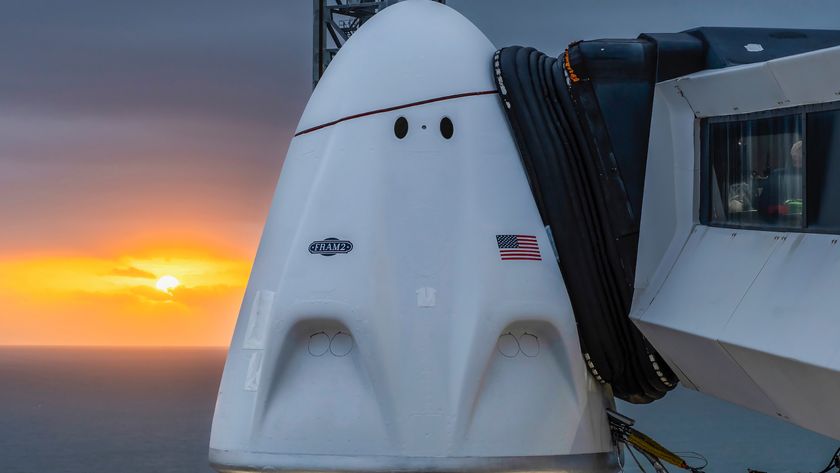
NASA is all set to launch its next mission to Mars on Monday (Nov. 18), provided the weather cooperates and no unexpected glitches pop up.
The Mars Atmosphere and Volatile EvolutioN orbiter, or MAVEN for short, is slated to blast off atop an Atlas 5 rocket at 1:28 p.m. EST (1828 GMT) Monday from Florida's Cape Canaveral Air Force Station. You can watch MAVEN's launch on SPACE.com, courtesy of NASA TV.
As its name suggests, MAVEN will make detailed measurements of the Red Planet's atmosphere from orbit, helping scientists understand why and how Mars' climate has changed so dramatically over the last few billion years. It will take about 10 months to reach Mars, and arrive at the Red Planet in September 2014. [NASA's MAVEN Mars Probe: 10 Surprising Facts]
Here are some key facts to keep in mind about the MAVEN probe and its $671 million mission:
MAVEN is big
The solar-powered MAVEN spacecraft is pretty hefty. While the probe's body is a cube measuring 8 feet (2.4 meters) on a side, MAVEN spans a total of 37.5 feet (11.4 meters) with its solar panels deployed, making the craft as long as a school bus.
And MAVEN weighs 5,410 pounds (2,454 kilograms) — as much as a fully loaded sport utility vehicle.
Get the Space.com Newsletter
Breaking space news, the latest updates on rocket launches, skywatching events and more!
Elliptical orbit
When MAVEN gets to Mars, the probe will insert into an elliptical orbit around the planet that brings it as close as 93 miles (150 kilometers) and reaches as far away as 3,728 miles (6,000 km).
In addition, MAVEN will make a handful of "deep dips" during the course of its mission, coming within 77 miles (124 km) of the Martian surface on five separate occasions. MAVEN will thus be able to sample the Red Planet's upper atmosphere directly and get a wider view of the entire planet from afar — a powerful combination, NASA officials say.

Solving a Martian mystery
Mars was a potentially habitable planet billions of years ago, with a thick atmosphere and large amounts of liquid water flowing across its surface. But then something happened, and the Red Planet transitioned to the cold and dry world we know today, with an atmosphere just 1 percent as dense as that of Earth. [NASA's MAVEN Mission to Mars (Photos)]
Scientists hope MAVEN helps them get a better handle on this dramatic shift. The mission aims to determine how and why much of the Martian atmosphere was lost to space, and what role this loss played in Red Planet climate change over the last four billion years.
MAVEN will use eight different science instruments to study Mars' upper atmosphere and the solar wind, the stream of charged particles flowing from the sun that is thought to have stripped away much of the water and other volatile compounds in the Red Planet's air.

While MAVEN's observations should help researchers better understand Mars' past and present habitability, the mission will not actively search for signs of life.
In fact, MAVEN is not equipped to sniff for methane, a gas that could be an indicator of extant life. (About 90 percent of Earth's methane is produced by living organisms.) MAVEN's budget could not support adding a methane-detection component, mission scientists have said.
Communications link
While NASA is most excited about the data MAVEN will gather, the spacecraft will also serve the space agency in another way — as a communications relay beween rovers on Mars and their handlers on Earth.
NASA currently has two rovers exploring the Red Planet's surface — the car-size Curiosity, which touched own in August 2012, and its smaller cousin Opportunity, which landed in January 2004. MAVEN will augment data relay from the two robots, which is currently provided by two NASA orbiters — Mars Odyssey, which launched in 2001, and the Mars Reconnaissance Orbiter (MRO), which blasted off in 2005.
This relay capability helped the MAVEN mission stay on track despite last month's government shutdown, which forced NASA to furlough 97 percent of its employees and cease most operations. While MAVEN launch preparations were halted at the beginning of the 17-day shutdown, the space agency granted the mission an emergency exception two days later, chiefly because of its importance as a communications link. (The agency has no relay orbiters on the books beyond MAVEN.)
Find the latest MAVEN news, photos and videos on SPACE.com. You can also follow MAVEN coverage through the Mission Status Center at SPACE.com's partner, Spaceflight Now.
Follow Mike Wall on Twitter @michaeldwall and Google+. Follow us @Spacedotcom, Facebook or Google+. Originally published on SPACE.com.
Join our Space Forums to keep talking space on the latest missions, night sky and more! And if you have a news tip, correction or comment, let us know at: community@space.com.

Michael Wall is a Senior Space Writer with Space.com and joined the team in 2010. He primarily covers exoplanets, spaceflight and military space, but has been known to dabble in the space art beat. His book about the search for alien life, "Out There," was published on Nov. 13, 2018. Before becoming a science writer, Michael worked as a herpetologist and wildlife biologist. He has a Ph.D. in evolutionary biology from the University of Sydney, Australia, a bachelor's degree from the University of Arizona, and a graduate certificate in science writing from the University of California, Santa Cruz. To find out what his latest project is, you can follow Michael on Twitter.










